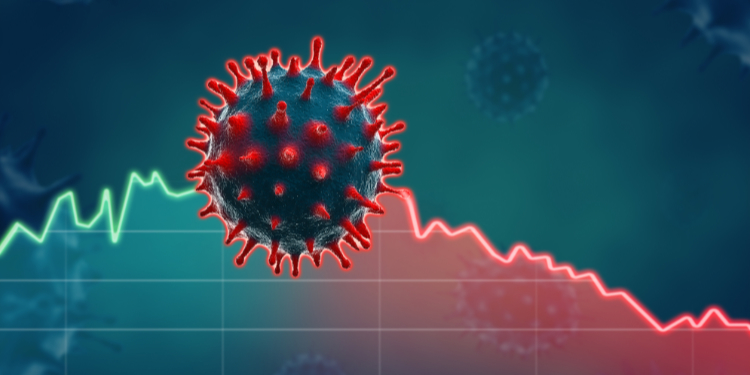With the declaration of a national emergency in early March of 2020, the United States formally joined the list of countries around the world implementing nonessential business closures and social distancing policies in response to the coronavirus disease (COVID‐19). As individuals, businesses, and the U.S. government responded to protect public health and combat the spread of the novel coronavirus disease, our collective actions have not been without consequences. While food production, including aquaculture, has been deemed essential, and the operation of farms has been allowed to continue, the loss of major market channels and interruption of other business sectors has resulted in a variety of different impacts and challenges for the U.S. aquaculture industry. It is estimated that the majority (68%) of seafood in the United States is consumed outside of the home (National Marine Fisheries Service 2018). In some instances, such as mollusks, estimates are that only 4% of primary point of sales are direct to consumers (USDA 2019). Under such conditions, the closure of food service establishments and implementation of shelter‐at‐home policies means a significant disruption in the sales of aquaculture and seafood products. In response to reports from industry, a collaborative effort between the Virginia Tech Seafood Agricultural Research and Extension Center (AREC) and The Ohio State University Extension was initiated in March of 2020 to assess the impacts of COVID‐19 on U.S. aquaculture, aquaponics, and allied businesses. While this study is scheduled to continue for the duration of 2020, to capture the evolving impacts of COVID‐19, the results from the first quarter survey paint a troubling picture and worrisome outlook for the U.S. aquaculture industry.
The summary of findings shared in this editorial represents the usable responses (537) to the first quarter survey, representing approximately 18% of all U.S. aquaculture producers (USDA 2019). Despite the accelerated timeline, the survey instrument underwent a standardized process of development, including expert review, pretesting, and Institutional Review Board review (van Senten, Smith, and Engle 2020). The survey instrument was not designed to capture any personally identifiable information, and individual responses were treated as confidential. It is important to note that respondents self‐selected for participation in the study, and no probabilistic sampling method was used because of time constraints. As a result, it is possible that the findings discussed here are skewed toward farms and businesses that have been more affected by COVID‐19. However, given the effects and impacts reported by participating producers, it is very likely that nonrespondents are experiencing similar challenges.
1 KEY FINDINGS
Of the 537 responses, 90% indicated that their business had been impacted by the coronavirus disease pandemic (van Senten, Smith, and Engle 2020). Of respondents, 7% were uncertain if their business had been impacted, and only 3% reported that their business had not been impacted in the first quarter (van Senten, Smith, and Engle 2020). Respondents to the first quarter survey covered the extent of the U.S. industry, representing different species groups (catfish, trout, oysters, clams, etc.), target markets (food, recreation, ornamental, etc.), and United States Department of Agriculture (USDA)‐defined aquaculture regions (Southern aquaculture region, Northeast aquaculture region, etc.). Responses were also representative of the range of farm sizes, from small producers with less than $1,000 in annual sales to large producers with in excess of $1 million of annual sales. Likewise, a variety of market channels were identified in the responses, with some producers reporting direct sales to consumers (18%) or grocery stores (3%), but the majority (78%) reporting primary sales to distributors, processors, restaurants, other aquaculture producers, or being vertically integrated (van Senten, Smith, and Engle 2020). While there are differences in how the various sectors of the industry have been impacted, currently under further investigation, there are a few common themes that have emerged from the data.
2 LOST SALES
The primary challenge for the U.S. aquaculture industry has been the loss of traditional market channels and the resulting loss of revenue. More than three‐fourths of respondents (84%) reported lost sales and canceled contracts or orders during the first quarter of 2020 (van Senten, Smith, and Engle 2020). In some instances, lost sales were reported to be in excess of $1 million for the quarter. Respondents noted lost sales in both domestic and international export markets. Furthermore, more than three‐fourths (86%) of respondents also expected to experience further lost sales in 2020 as a result of the COVID‐19 pandemic (van Senten, Smith, and Engle 2020). The effects of lost sales on the long‐term viability of the business were also assessed, to which responses noted that farms could survive for limited periods of time without sales before suffering long‐term cash flow effects. Respondents also expressed concerns with the increased risk of losses because of holding market‐ready products for extended periods and the likely effects of delayed sales on product marketability and price. For example, allowing oysters to grow larger will make them unsuitable for higher‐value half‐shell markets. Similarly, allowing fish to grow larger may result in challenges for processing and marketing of specific product forms. Holding market‐sized inventory increases per‐unit costs and exposes the farm to greater risks of oxygen and disease problems because of the much greater animal biomass. In response to the challenges presented by lost sales, we are seeing many businesses attempt to establish new marketing channels. Many farms are actively developing channels to sell direct to consumers, but adaptation requires resources and, in many cases, training and regulatory approval. For all of U.S. agriculture, the coronavirus disease has revealed how extremely difficult it is for a farm or allied business to pivot marketing channels in an attempt to recapture lost sales. It should be noted that, for many sectors of U.S. aquaculture, spring is a peak marketing period and a time when many farms can obtain the best prices for their products. The effects of lost sales are therefore very likely to present additional challenges for the industry for the duration of 2020 and beyond.
3 LABOR
A second theme that has emerged from the data is the challenges with labor experienced by the industry. These challenges include the temporary loss of employees because of illness or shelter‐at‐home orders and furloughs or layoffs of employees resulting from the lack of incoming revenue for the business. A third of first quarter respondents indicated that their business had already laid off employees, with another quarter of respondents indicating that their business “would have to soon” (van Senten, Smith, and Engle 2020). The majority of respondents indicated that this affected between 1 and 3 employees, but there were instances reported where over 100 positions within the business had been terminated. Respondents also reported pay cuts for owners and management and temporary furloughs across the business. Concerns were expressed about the loss of specialized and trained labor and the inability to adequately manage production or processing as a result of a reduced labor force. Respondents also expressed concerns about the safety and well‐being of their employees. The resulting challenges with labor because of the coronavirus disease pandemic will likely also have longer‐term consequences for the U.S. aquaculture industry.
4 CHALLENGES TO THE FARM OR BUSINESS
First quarter survey respondents indicated that they had experienced challenges with a variety of production inputs, goods, or services that were essential to the operation of their business. Many noted challenges in obtaining necessary production inputs, such as feed or seed. Respondents also noted challenges because of a lack of important services, such as repair and maintenance for infrastructure and equipment. Some reported challenges in obtaining diagnostic or testing services. Nearly half of responding farms indicated that they expected to experience further production challenges in 2020 because of COVID‐19 (van Senten, Smith, and Engle 2020). Producers also noted that holding market‐ready products would interfere with their ability to prepare or start the production of future crops, implying future interruptions in the availability of product and cash flow for the farm. While the specific challenges faced by respondents varied across the different species groups and marketing channels, it is clear that the shutdown of other businesses (deemed nonessential) in response to COVID‐19 has had, and will continue to have, an impact on aquaculture producers. Loss of employment in other sectors of the U.S. economy, such as retail and manufacturing, may also result in different consumption patterns amongst consumers that may affect U.S. aquaculture producers in the future.
5 CONCLUSION
While there are a multitude of specific challenges because of the highly diversified nature of the U.S. aquaculture industry, these three areas have emerged as common thematic issues for respondents of the first quarter survey. When the survey was launched on March 23rd, there had not yet been an official announcement of federal or state support programs for U.S. aquaculture producers and small businesses. Survey participants were asked about existing programs or measures that could help their businesses survive the current challenges, but the majority of respondents (77%) did not respond to this question (van Senten, Smith, and Engle 2020). Respondents indicated that, without some form of external intervention, their farms or businesses would struggle to survive. Only a third of respondents (34%) indicated that their farm or business could survive 3 months without external intervention, with 50% of respondents stating they would not survive 12 months without external intervention (van Senten, Smith, and Engle 2020). As this study is ongoing, we will assess the impacts of the relief programs and support measures that have been announced in future iterations of the survey. Given all that we have learned from the first quarter impacts of COVID‐19 on the U.S. aquaculture industry, we believe it safe to conclude that there will be longer‐term effects for the industry. Based on the implementation of similar measures and policies in response to COVID‐19 in other countries, we would encourage other researchers and extension specialists around the world to perform similar impact assessments for their aquaculture sectors. The data collected from such endeavors may not only be helpful in the immediate term to the industry seeking additional support or aid but could be of value in the future when assessing vulnerabilities and opportunities for adaptation and mitigation to improve the resiliency of aquaculture to global pandemics and other interruptions to traditional market channels.
For additional information and disaggregated detailed results on the impacts of COVID‐19 on the U.S. aquaculture industry, please visit: https://www.arec.vaes.vt.edu/arec/virginia-seafood/research/Impacts_of_COVID19.html
- National Marine Fisheries Service. (2018). Fisheries of the United States, 2017 . U.S. Department of Commerce, NOAA Current Fishery Statistics No. 2017. Retrieved from https://www.fisheries.noaa.gov/resource/document/fisheries-united-states-2017-report
- United States Department of Agriculture. (2019). 2018 census of aquaculture . National Agricultural Statistics Service, Washington, DC: USDA. Retrieved from https://www.nass.usda.gov/Surveys/Guide_to_NASS_Surveys/Census_of_Aquaculture/index.php
- van Senten, J., Smith, M. A., & Engle, C. R. (2020). Impacts of COVID‐19 on U.S. aquaculture, aquaponics, and allied businesses: Quarter 1 results. Virginia cooperative extension factsheet . AAEC‐218. Retrieved from https://www.pubs.ext.vt.edu/content/dam/pubs_ext_vt_edu/AAEC/aaec-218/AAEC-218.pdf


















